Vol 4 No. 21 TROPIC LIGHTNING NEWS May 26, 1969
Index
102 NVA Die, Huge Cache Taken
3d Brigade Scores in Trapezoid
By SP5 JACK ANDERSON
DAU TIENG - Infantrymen of the Tropic Lightning’s 3d Brigade continued
mop up operations after they had successfully overrun a huge enemy base camp area in the
Trapezoid, killing 102 of the defenders. They also detained one suspect during two days of
fighting.
On the first day, troopers from four infantry companies discovered 36 enemy
bodies, many of them sprawled in heavily fortified bunkers concealed in the thick bamboo.
During sweep operations on the second day, they found an additional 57 enemy bodies and
killed nine more enemy soldiers.
Many of the enemy dead were attributed to a series of eight tactical air
strikes and more than 4,400 rounds of artillery that were poured into the area while the
infantrymen assaulted the bunker complexes.
The four-company force was responding to a tip from a hoi chanh who told
officers that an entrenched enemy unit, some 200 to 250 men, would fight to the last man
defending what he said was a large arms and food cache for the planned summer offensive.
Later, a detainee stated there were 200 to 400 men in the area.
"The hoi chanh spoke only Vietnamese during most of the operation,"
said Major Jerry Holliday of Memphis, Tenn. operations Officer of 1st Battalion, 27th
Infantry Wolfhounds. "All of a sudden, he started shouting in English as we
approached a woodline. It was at this time when he told us about the enemy force,"
Holliday said.
See page 7 for a photo feature by SP5 Jack Anderson covering the 3d Brigade operation. |
On the first day of operations, the U.S. force pulled back twice to let its
artillery and air support soften the area more thoroughly, before it successfully overran
the bunker complexes. "The RPGs were falling in on us like rain that first day,"
said Captain Raymond Kauffman of Lexington, Ky., commander of Charlie Company, 2d
Battalion (Mechanized), 22d Infantry. "We had two APCs damaged on the first
assault," he said.
Later in the day, when the troopers succeeded in penetrating the enemy
defenses, they found heavily fortified bunkers that were almost indestructible.
"Those fortifications were so thick and well constructed that our tracks couldn't
even crush them when we ran over them," said Captain David Crocker of Old Mystic,
Conn., Alpha Company 2/22 commander.
The going was a little easier on the second day of fighting. "We didn't
meet much opposition," the Wolfhounds' Holliday said. "Most of the enemy had
been killed the day before by small arms, air and arty. But we did find big, wide trails
leading south and west, and it looked as if they had dragged a lot of the cache away. I
don't see how they could have had much left because they fired almost everything at us the
day before."
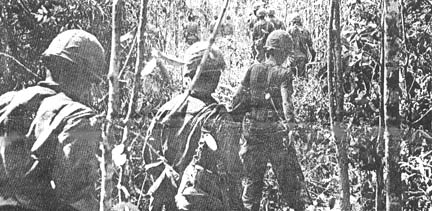 One of the most important discoveries of the operation was an estimated
49,000 pounds of rice found in several caches near bunker complexes. The troopers also
discovered 1,400 pounds of salt, 12 AK-47 assault rifles, four crew-served weapons, four
rifle (Continued on Page 7)
One of the most important discoveries of the operation was an estimated
49,000 pounds of rice found in several caches near bunker complexes. The troopers also
discovered 1,400 pounds of salt, 12 AK-47 assault rifles, four crew-served weapons, four
rifle (Continued on Page 7)
BAMBOO AND DENSE undergrowth slow down search efforts in this base camp. These Wolfhounds from the 1st Battalion, 27th Infantry, are searching for bunkers and food caches to add to the more than 49,000 pounds of rice found nearby.
Hawaii Comes to the Tropic Lightning Division
CU CHI - Someday, perhaps, the subject and verb of the headline above will be
transposed, but for the time being 25th Division soldiers will be satisfied with a little
bit of Hawaii coming to the Tropic Lightning Division. For a while, members of B Company,
2d Battalion, 12th Infantry, thought they were in Hawaii .
It certainly didn't look like the hot, dusty place they have become
accustomed to. There were palm trees, green grass, lounge chairs with sun umbrellas and
even a snack bar selling stateside hamburgers and pizza.
But most of all there was the swimming pool, "Waikiki East."
The Warriors were the first stand-down unit to enjoy the new swimming pool at
Cu Chi base camp. And enjoy it they did. Courtesy of the management, the opening day crowd
had free beer, soft drinks and free food.
General Ralph E. Haines, commanding general of the United States Army,
Pacific, was there for the opening ceremonies to cut the ribbon and say:
"I am proud to have a role in opening this grand new swimming pool which
is a credit to the ingenuity and imagination of the Tropic Lightning Division."
The pool took four months to construct. Its design is as "Hawaiian"
as possible, a reminder that Tropic Lightning’s home is in Oahu, Hawaii, at Schofield
Barracks. A Hawaii state flag flies proudly over the pool’s bath house.
Major General Ellis W. Williamson, commander of the 25th, escorted General
Haines to the pool after a survey of the Division area of operations earlier in the day.
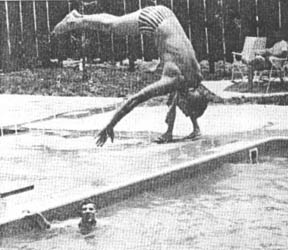 The generals were met at the entrance to the pool by Sergeant First Class
Mauna Maunakea of Honolulu and Specialist 4 Gaylord Defries of Kahului, Maui. Both were
decorated with the traditional leis.
The generals were met at the entrance to the pool by Sergeant First Class
Mauna Maunakea of Honolulu and Specialist 4 Gaylord Defries of Kahului, Maui. Both were
decorated with the traditional leis.
It didn't take long after the official opening for the Warriors to start
whooping it up.
"It really makes a stand-down seem like a vacation," said one
infantryman.
SO EXCITED he doesn't know which end is up. At least that’s the way it looks as this diver seems to enter the Waikiki East pool with his forefeet first. (PHOTO BY SP4 PAUL IADEROSA)
About this time each year back in the world everyone is reminded that school will be out soon and safe-driving season is approaching. This season, as every season in Vietnam, is safe-driving season. Whether on base camp or on the open rood, safety depends on you. |
Page 2 TROPIC LIGHTNING NEWS May 26, 1969
Decorated
| BRONZE STAR MEDAL (HEROISM) | |
| MAJ Milton D. Ewanus, HHC, 2d Bn,
27th Inf CPT Theodore Flannagan, HHC, 2d Bn, 27th Inf CPT Michael D. Jackson, B Trp, 3d Sqdn, 4th Cav CPT Walter L. Mayhew, HHB, 2d Bn, 77th Arty 1LT Charles J. Johnston, 25th MP Company 1LT James McKinley Jr., Co C, 1st Bn, 5th Inf CSM Charles L. Smith HHB, 2d Bn, 77th Arty SFC Ronald D. Cooper, HHB, 2d Bn, 77th Arty SFC Homer R. Beck, HHB, 2d Bn, 77th Arty SFC Robert A. Maxey, B Trp, 3d Sqdn, 4th Cav SFC Paul D. Jarvis, HHC, 1st Bn, 27th Inf SFC Ransom Jordan Jr., B Btry, 2d Bn, 77th Arty SSG Frederick W. Hallman, A Trp, 3d Sqdn, 4th Cav SSG Manuel R. Tafoya, A Trp, 3d Sqdn, 4th Cav SSG Joseph Haggwood, HHB, 2d Bn, 77th Arty SSG Thomas P. Furtney, HHB, 2d Bn, 77th Arty SSG Brin P. Hessinger, Co C, 1st Bn, 5th Inf SGT Harrison L. Cook, HHC, 2d Bn, 34th Armor SGT Ronald E. Dummer, C Btry, 2d Bn, 77th Arty SGT Steven M. Sutphin, C Btry, 2d Bn, 77th Arty SGT James H. Weifenbach, HHB, 2d Bn, 77lh Arty SGT Gary Mannich, 25th MP Company SGT Orville L. Kurth, HHC, 1st Bn, 5th Inf SGT Russell Seep, C Trp, 3d Sqdn, 4th Cav SGT Hector N. Nadal, HHC, 1st Bn, 27th Inf SGT Dennis M. Rogue, Co C, 1st Bn, 5th Inf SP5 Harold T. Gillespie, Co E, 2d Bn, 27th Inf SP5 Bradford E. Turgeon, Co C, 65th Engr Bn SP5 Frank R. Rodriguez, C Btry, 2d Bn, 77th Arty SP5 Robert L. Hull, HHC, 1st Bn, 27th Inf CPL William D. Burson, C Btry, 2d Bn, 77th Arty SP4 Vincent J. Vizzari, HHB, DIVARTY SP4 George W. Jones, HHB, 2d Bn, 77th Arty SP4 Randy W. Engelgau, Co B, 4th Bn, 23d Inf SP4 Ramon Perez, Co B, 2d Bn, 14th Inf SP4 Michael L. Flanary, B Btry, 1st Bn, 8th Arty SP4 David E. Peterson, C Btry, 2d Bn, 77th Arty SP4 Phillip A. Tatum, Co D, 2d Bn, 27th Inf SP4 Richard J. Foshey, HHC, 1st Bn, 27th Inf SP4 David S. Hamilton, HHC, 1st Bn, 27th Inf SP4 Peter J. Arnone, Co B, 1st Bn, 27th Inf SP4 Clement M. Brierly, Co E, 1st Bn, 27th Inf SP4 Michael L. Arbogast, Co E, 1st n,. 27th Inf SP4 Gregory L. Rush, HHB, 2d Bn, 77th Arty SP4 Phillip L. Fadley, HHB, 2d Bn, 77th Arty SP4 Kenneth J. Pierce, HHB, 2d Bn, 77th Arty |
SP4 Stanley W. Serich, HHC, 1st
Bn, 27th Inf SP4 Joseph Hamilton, HHC, 1st Bn, 27th Inf SP4 Kim C. Perry, HHC, 1st Bn, 27th Inf SP4 James L. Holton, HHB, 2d Bn, 77th Arty SP4 Peter J. Smith, Co E, 1st Bn, 27th Inf SP4 Michael D. Clark, C Btry, 2d Bn, 77th Arty SP4 Thomas E. Glosgow, HHB, 2d Bn, 77th Arty SP4 Carl R. Hathaway, Co E, 1st Bn, 27th Inf SP4 Clifton McMennamy, 25th MP Company SP4 Rodney A. Martin, Co E, 1st Bn, 27th Inf SP4 Bill Shrawder, HHC, 3d Bde SP4 Thomas A. Lange, B Trp, 3d Sqdn, 4th Cav SP4 Jack E. Noble, B Trp, 3d Sqdn, 4th Cav SP4 Marion T. Johnson, B Trp, 3d Sqdn, 4th Cav SP4 James L. Ball, B Trp, 3d Sqdn, 4th Cav SP4 David Navarro, B Trp, 3d Sqdn, 4th Cav SP4 Stephen W. Marriman, A Trp, 3d Sqdn, 4th Cav SP4 Edward A. Bodzinski, C Trp, 3rd Sqdn, 4th Cav SP4 Robert M. Grape, Co A, 2d Bn, 27th Inf SP4 Melvin La Bostrie, Co A, 2d Bn, 27th Inf SP4 Anthony E. Ippolito, C Trp, 3d Sqdn, 4th Cav SP4 John Stewart, Co A, 1st Bn, 5th Inf SP4 Hobart M. Matcalfe, A Trp, 3d Sqdn, 4th Cav SP4 Martin W. Frantz, Co C, 65th Engr Bn SP4 George E. Chavez, Co C, 1st Bn, 5th Inf SP4 Stephen D. Dodd, Co C, 1st Bn, 5th Inf SP4 David K. Keyes, Co C, 1st Bn, 5th Inf PFC Bobby D. Martin, 2d Bn, 77th Arty PFC Ronnie N. Blackburn, Co C, 2d Bn, 12th Inf PFC Marion A. Woodfork, Co C, 2d Bn, 12th Inf PFC Glen Bambulat, Co D, 2d Bn, 12th Inf PFC Marinez A. Bejito, Co D, 2d Bn, 12th Inf PFC Daniel A. Latshaw Jr., Co D, 2d Bn, 12th Inf PFC Daniel D. Overkamp, Co E, 1st Bn, 27th Inf PFC John R. McIntosh, Co B, 1st Bn, 27th Inf PFC Charles J. Rock, Co B, 3d Bn, 22d Inf PFC Charles E. Chance, Co E, 1st Bn, 27th Inf PFC Duarl G. Richardson, HHB, 2d Bn, 77th Arty PFC John C. Helton, HHC, 1st Bn, 27th Inf PFC Wilken R. Walker, Co E, 1st Bn. 27th Inf PFC Wesley J. Wilber, Co A, 3d Bn, 22d Inf PFC Joseph C. Topasna, Co B, 1st Bn, 5th Inf PFC Robert S. Gottshall, B Trp, 3d Sqdn, 4th Cav PFC Steven Poe, B Trp, 3d Sqdn, 4th Cav PFC Vince H. Salveston, B Trp, 3d Sqdn, 4th Cav PFC Leon Siebert, B Trp, 3d Sqdn, 4th Cav |
Over $1,000 per day
VRB Cache at Re-Up
Office
The 25th Infantry Division’s re-enlistment office has paid out over
$100,000 in variable re-enlistment bonuses during the past three months.
That’s a lot of VRB, more than a 100 per cent increase over the previous
three months' figures. One thousand dollars per day or more are being paid in bonuses, and
all indications are that the high rate of payments will continue.
"The money spent is well worth it though," Major Fredrick
Bangasser, Tropic Lightning’s Re-enlistment Officer, said.
"The 25th Infantry Division has the best people anywhere, and by
persuading these quality people to re-enlist, the government is saving money in the long
run."
It is difficult to put a price tag on the worth of top quality personnel who
are already trained and accustomed to Army life, but Major Bangasser indicates that the
25th has every intention of keeping the price high.
"We expect June’s VRB payments to exceed those of any of the three
previous months," the major said. There’s a lot of cash involved, no doubt about
it. Maybe some of it could be yours. Think about it. Call up the Re-Up Office.
Memorial Day Message by Melvin Laird
Memorial Day is an appropriate time for all members of our
Armed Forces to reflect on the precious heritage of freedom bequeathed to us by our
forefathers. For nearly two centuries - from Lexington and Concord to Vietnam - Americans
have fought bravely to defend and preserve this heritage. In so doing, many gave their
lives so that our Nation could maintain its freedom and integrity.
As America pays tribute to its war dead on this day, we must realize that
only if we cherish our freedom and defend it against all assaults, can we hope to retain
it. Our ultimate hope is for an enduring peace that will make the freedom protected by
their sacrifice secure for all time.
It is only from the gallantry, patriotism, and devotion to duty of those who
have gone before that we, the living, can draw inspiration and dedication. We honor their
memory with the promise that America will always remember their contribution to our
security in times of peril.
Melvin R. Laird
Tropic Lightning Tots
The Commanding General Welcomes
The Following Tropic Lightning Tots
To The 25th Infantry Division – As
Reported By The American Red Cross.
Born To:
| May 5th 1LT Robert R. Farrar, 25th MP Co, a daughter May 6th SP4 Lorenzo W. Kup, 25th Co, a son May 7th SP4 Dennis Flood, Co E, 65th Engr Bn, a son SP4 Charles M. Crosly, C Trp, 3d Sqdn, 4th Cav, a son PFC Kirk Votler, Co A, 2d Bn, 12th Inf, a daughter |
May 9th SP4 Anselmo Quinonez, HHC, 25th Med Bn, a son SP4 James L. McClaskey, Jr., 242d AHC, a daughter SP4 David J. Dedrick, HHD, 125th Signal Bn, a daughter May 10th 1LT Joseph Krawczyk, Co B, 3d Sqdn, 4th Cav, a daughter May 11th 1LT William T. Taylor Jr., HHC, 2d Brigade, a son |
The TROPIC LIGHTNING NEWS is an authorized publication of the 25th Infantry Division. It is published weekly for all division units in the Republic of Vietnam by the Information Office, 25th Infantry Division, APO San Francisco 96225. Army News Features, Army Photo Features, Armed Forces Press Service and Armed Forces News Bureau material are used. Views and opinions expressed are not necessarily those of the Department of the Army. Printed in Tokyo, Japan, by Pacific Stars and Stripes.
MG Ellis W. Williamson . . . . Commanding General
MAJ John C. Fairbank . . . . . Information Officer
1LT John C. Burns . . . . . . . . Officer-in-Charge
SP4 Robert Imler . . . . . . . . . . Editor
SP5 Charles Withrow . . . . . . Assistant Editor
SP4 Ralph Novack . . . . . . . . Production Supervisor
VC Rocket Angers Village
TAY NINH - In the hamlet of Binh Phong near Tay Ninh Base Camp, a Vietnamese
woman and two small children were killed while they slept huddled together in a house. A
Chinese 107mm rocket shattered the house’s corrugated tin roof adding more shrapnel
to its killing zone.
Without any governmental supervision or encouragement, a group of embittered
inhabitants of Binh Phong hamlet banded together to inform their neighbors of the Viet
Cong’s killings.
They constructed a seven foot by four foot cardboard poster: its lettering,
with a crude drawing of a Viet Cong and rocket read, "Kill the Viet Cong! The Viet
Cong Launched a Rocket That Killed a Woman and Two Children."
Major Clarence M. DeYoung, San Diego, Cal., 1st Brigade Civic Action Officer,
stated, "The poster was positioned in the center of the hamlet for days. While people
looked at it, other people retold the tragic story and urged their neighbors to resist the
Viet Cong."
Accidents Must Be Cut
Recent traffic accident rates in the second Field Force’s area of
operations have drawn a letter from Lieutenant General Julian J. Ewell, Commanding
General.
Accident reports, the letter indicates, daily attest to the lack of attention
to defensive driving on the part of the individual and the lack of command interest at all
echelons. An analysis of the reports reveals the majority of the accidents could have been
prevented had the vehicle operators exercised a greater degree of caution and
consideration for others.
During the last six months, 53 Vietnamese citizens and eight US soldiers have
died in traffic accidents involving US force’s vehicles. During this period 69 US
soldiers and 39 Vietnamese civilians were seriously injured.
Because of the concern raised by this poor record, immediate positive,
forceful, corrective action is expected of all personnel and all echelons.
Radio Show Needs You
Would you like a new audience for your stories, war and otherwise? Do you
know of someone who has something to say? Do you know of singing groups in the Division?
Or any unusually interesting people?
If the answer to any of these slightly rhetorical questions is yes, by all
means contact SP4 Jack Schmitt in the Tropic Lightning Information Office, Cu Chi phone
number 5011.
Chances are good you'll quickly be on one of the Division’s weekly radio
programs. You don't have to be a pro to be on the show. You do need something of interest
to share with the Division.
Page 3 TROPIC LIGHTNING NEWS May 26, 1969
ASD Keeps Them That Way
Dau
Tieng Runways Safe
By SP5 RICK ADAMS
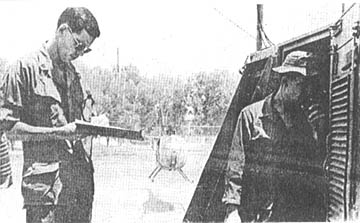 DAU TIENG - At times the 3d Brigade base camp at Dau Tieng sounds like the
artillery center of the world. For most people here, it’s just a problem of hearing
yourself think. But for the 16 men that make up the 319th Aviation Support Detachment, it
creates a few more problems.
DAU TIENG - At times the 3d Brigade base camp at Dau Tieng sounds like the
artillery center of the world. For most people here, it’s just a problem of hearing
yourself think. But for the 16 men that make up the 319th Aviation Support Detachment, it
creates a few more problems.
The 319th is responsible for controlling and directing as many as 1,500
aircraft that use the Dau Tieng runway daily. "Artillery fire missions and circling
aircraft don't mix very well - and that is where we come in," stated Private First
Class Fred Davis of Monterey, Calif.
The 20-year-old air controller added, "The only time it gets really
hectic is when our batteries fire in several directions, which is not uncommon here."
Artillery fire isn't the only hazard that the 319th must advise pilots about.
"Several times we've had to tell pilots where to expect ground fire," recalled
Specialist 5 Dympse Bowlin, a 25-year-old from Laurel Springs, N.C.
The controllers operate from a tower-booth along the main runway at Dau
Tieng. The booth, looking like the bridge of a naval vessel with its FM, VHF, and UHF
radio antennas, is perched atop several steel conex containers and affords the ASD team
clear view of the air lanes.
"Sometimes we even act as linguists," explained Specialist 4
Charles Eckhardt of Wynot, Neb. "A couple times a week we assist French and
Vietnamese pilots, and it’s really an experience helping them land safely here."
The air controllers' day ends about four hours after they fire up the flare
pots which light the runway at night. With the group’s constant companion, a dog
named Susie, they take a break from the very hectic and pressing job of landing thousands
of dollars worth of Air Force and Army aircraft.
Despite the many flight hazards at Dau Tieng, the 319th can boast a spotless
record with no accidents in the nine months of controlling air movements here.
CO-ORDINATION - [Photo, above
right] A 3d Brigade Cayuse hovers near
the 319th Aviation Support Detachment tower as Private First Class Fred Davis of Monterey,
Calif., records the latest air movements and Specialist 4 Mike Gironimi, Norway, Mich.,
directs another aircraft around Dau Tieng artillery patterns. (PHOTO BY SP5 RICK
ADAMS)
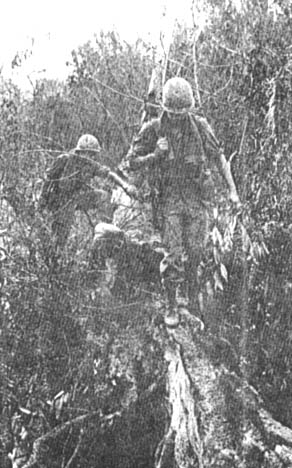 Ambush Kills Six
Ambush Kills Six
TAY NINH - An alert ambush patrol from Company B, 4th Battalion (Mechanized),
23d Infantry, killed six Viet Cong who were preparing two mortar positions. The positions
were being readied to launch attacks on a Tropic Lightning fire support base 19 miles
north of Tay Ninh City.
"We were lying in the grass when we saw nine VC walk right by us. They
calmly started digging twin mortar positions." said Sergeant Richard O. Allen of
Enid, Okla. "We waited for a few minutes so they would be wrapped up in their work
before we opened up."
In their hasty retreat the enemy left behind one AK-47 rifle, assorted web
gear, and twenty 82mm mortar rounds fused and ready to fire.
EASY NOW - [Photo, above right] Specialist 4 John E. Jones of Iowa
City, Iowa, finds that the dry way to cross a stream is a bit on the precarious side,
especially when the log bridge is half rolled and ready to collapse at any minute.
(PHOTO
BY SP4 KARL KARLGAARD)
The Brothers Duvall Tour Vietnam Together Again
DAU TIENG - The Brothers Duvall. Sound like a literary classic? No, not
really, but their story has epic proportions.
The brothers Duvall, James and Henry, both staff sergeants, have followed
each other around the world, courtesy of the U.S. Army. They're both on their second tour
in Vietnam now and both were assigned to the same unit they were in on their first tour,
725th Maintenance Battalion.
"On our first tour, we were both assigned to Delta Company as wheeled
vehicle mechanics," Henry said. "When I came over for my second tour, I was
assigned to Charlie Company, and I was in their orderly room one day and in walked my
brother. I had no idea he was over here too."
But that was neither the first nor second time the brothers had been
stationed together.
"In 1959, we were together in Korea," Henry said. "We were
light weapons infantrymen with the 7th Infantry Division. Then we both went to Ft. Knox,
Ky."
After remaining at Ft. Knox for a tour, the Brothers Duvall separated, for a
brief time. "I was assigned to Europe," Henry said, "and James went to Fort
Hood. I think I got the best deal."
Being stationed together most of the time does have its draw-backs, however.
"My brother and I have traded off being each others platoon sergeants almost since we
joined the Army," Henry said. "James was my sergeant in Korea, and I was his on
our first tour in Vietnam. Naturally, you always give your brother a harder time than the
other guys, but I guess we’ve pretty much evened the score on each other over the
years."
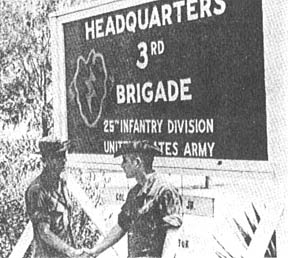 Another drawback comes from the administrative red tape involved in having
two men of the same name and same rank in one unit. Sometimes, my brothers and my records
get confused. It’s never anything serious, but, of course, we like to keep them
straight. Usually, on our leaves between assignments, we sit down for a couple of hours
and carefully go over the records and get things straight again," Henry said.
Another drawback comes from the administrative red tape involved in having
two men of the same name and same rank in one unit. Sometimes, my brothers and my records
get confused. It’s never anything serious, but, of course, we like to keep them
straight. Usually, on our leaves between assignments, we sit down for a couple of hours
and carefully go over the records and get things straight again," Henry said.
On this, their second tour in Vietnam, they became separated by a few miles
when Henry took a job as career counselor for the Tropic Lightning’s 3d Brigade at
Dau Tieng. James remained with the maintenance battalion in Cu Chi. Soon, he will return
to Korea for a second tour.
"We try to visit each other as often as possible," said Henry.
"It sort of makes the time go a little easier."
Will the Brothers Duvall meet again? "I hope so," said Henry. "I’d
like to see how far we can go with this buddy system."
BROTHERS - Staff Sergeants James (left) and
Henry Duvall meet at Dau Tieng base camp. James from D Company, 725th Maintenance
Battalion and Henry, a 3d Brigade career counselor have followed each other around the
world. (PHOTO BY SP5 JACK R. ANDERSON)
Page 4-5 TROPIC LIGHTNING NEWS May 26, 1969
Operation Roughrider: A Move to Remember
By SGT HERB BURDETT
TAY NINH - Units of the First Brigade transferred 100 military vehicles laden
with tons of equipment, supplies and materials from Tay Ninh to Thien Ngon Special Forces
Camp during Operation Roughrider. One U S. Division Commander called it a perfectly
planned and flawlessly performed military operation.
Only a few hours earlier infantrymen, artillerymen and engineers had been
poised at the gate of Tay Ninh base camp to make the arduous 25 mile trek along Route 22
through War Zone C to the Special Forces camp.
DOZERS, GRADERS and trucks from the
588th Engineer Battalion, charged with constructing a new airfield at Thien Ngon, were
weighted down with sandbags to protect the drivers and passengers from enemy bullets, grim
reminders the term War Zone C has real meaning.
Major Lloyd Brownfield, the 588th Operations Officer and First Lieutenant
Francis Smith, Company D Commander, looked over their last minute plans as vehicles from
the 23d Engineer Company took their place in line.
The light, mobile armored vehicles of the 4th Battalion, (Mechanized), 23d
Infantry, led the charge accompanied by minesweepers from Company A, 65th Engineer
Battalion, and B Battery, 7th Battalion, 11th Artillery. The artillery battery, commanded
by Captain John Ricca of Clark, N.J., joined the lead element to deploy their howitzers
along the road, providing direct artillery support for the convoy.
"IT WAS OUR JOB to keep the road
free of mines and the enemy," said Lieutenant Colonel G. E. Taylor of Shelby, N.C.,
commanding Officer of the Mech. "We provided flank and point security and stayed
right with the engineers, artillerymen and truck drivers all the way," continued
Taylor.
Colonel Charles W. Hayward of Andover. Mass., 1st Brigade commander, flew
overhead in his command and control helicopter keeping tabs on the convoy and coordinating
the many units involved in the operation. Howitzers, pulled by trucks of C Battery, 7th
Battalion, 11th Artillery, commanded by Captain Dennis Salz of Newark, N.J.,. could he
seen blending in with the other vehicles.
THE SIX 105 howitzers were ready to
deploy and protect the forces working at Thien Ngon. An AVLB (Armored Vehicle Launching
Bridge) from Company A, 65th Engineers, came into view, sandwiched by two armored
personnel carriers. The bridge would be used to span the Soui Tri Bi River, 29 miles
farther down the road.
Soon the command and control chopper was hovering over the river. Artillery
from Tay Ninh saturated the crucial crossing site near the Cambodian border with hundreds
of high explosive rounds. Company C of the 3d Battalion, 22d Infantry, air assaulted in on
the heels of the Artillery, and prepared to secure the crossing.
"WE MOVED ACROSS the foundations
of an old demolished bridge and set up security on both sides of the river," said
Captain William A Vestal of Glendale, Ariz, Commander of Company C. "We were extra
cautious because this is a known enemy stomping ground," continued Vestal.
Company B, 3d Battalion, 22d Infantry, under the direction of First
Lieutenant Hugh E. Stephens of Charleston, S.C., air assaulted into the jungles near Thien
Ngon and swept south to meet its sister company, neutralizing any potential enemy thrust
in the area.
Soon the convoy reached the river and the AVLB went to work. The
accordion-like bridge raised off its tank tread foundation and quickly spanned the river
in less than 40 minutes," said Captain Charles Nichols of Los Angeles, Calif.,
Commander of Company A, 65th Engineers. "The river bank was dry and solid, allowing
us to put the bridge in place with very little preparation," continued Nichols.
Over 100 vehicles of every type and description sped across the quickly laid
span. In just a matter of a few short hours the only bottleneck in the entire road had
been breached and the convoy had crossed.
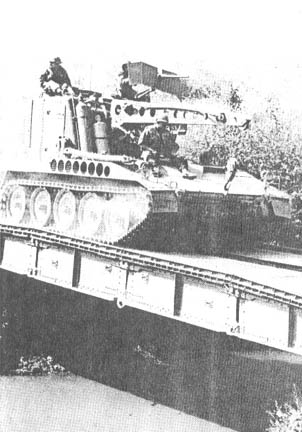 A FEW HECTIC hours passed and the
supplies were unloaded at Thien Ngon. Dozens of barrels of surfacing material were reeled
off their trucks and secured for the night.
A FEW HECTIC hours passed and the
supplies were unloaded at Thien Ngon. Dozens of barrels of surfacing material were reeled
off their trucks and secured for the night.
Fire Support Base Ord quickly took shape and the Tropic Lightning soldiers
settled down to make Thien Ngon their home for the next thirty days, the estimated time to
completion of the new airstrip. Company B, 4/23, commanded by Captain Luther Dewalt of
Cosby, Texas and C Battery, 7th Battalion, 11th Artillery, dug in to support and secure
the engineers.
Over 40 trucks and vehicles, minus the heavy cargoes, were soon on the way
back to Tay Ninh. Infantry and Mech. kept watch as the trucks rolled back across the
river. The bridge was quickly lifted, collapsed back on its tracks, and joined the convoy.
Over 148 crossings were made across the river without incident. Aside from
the normal communications checks and coordinative radio conversations the only message
that came across the 1st Brigade tactical radio net that day was the voice of the
Commanding General of the 25th Infantry Division. Major General Ellis W. Williamson
praised Colonel Hayward for the perfect execution of a difficult and dangerous mission.
A TANK RETRIEVER [Above, right] from the 4th Battalion
(Mechanized), 23d Infantry, is a must for this operation. The retriever will be used to
off-load boxes of ammo and equipment once they reach Thien Ngon. (PHOTO BY SGT HERB
BURDETT)
Photos tell the story of Operation Roughrider. The top left pic shows
engineers of the 588th loading PSP. An Armored Vehicle Launching Bridge from A Company,
65th Engineers, rumbles along Route 22 to Thien Ngon in photo at top right. The center
left shot shows the AVLB in use as a 12-ton grader crosses the Soul Tri Bi River. The
heavy work is underway in photo at center right as an earth mover starts its long task of
leveling the surrounding terrain. Artillery support was established immediately (bottom
left) as 105’s from C Battery, 7th Battalion, 11th Artillery, were quickly set up.
The last shot shows part of the 1,200 rounds of ammunition being unloaded. (PHOTOS BY 1ST
BRIGADE STAFF)
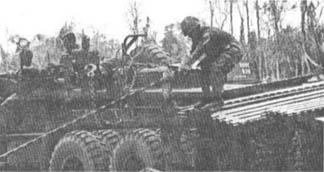 |
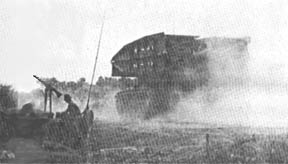 |
|
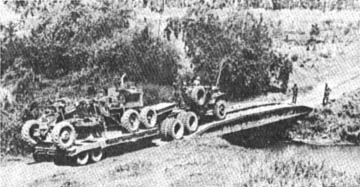 |
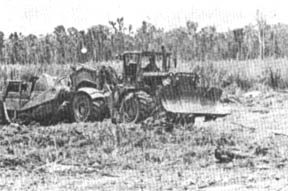 |
|
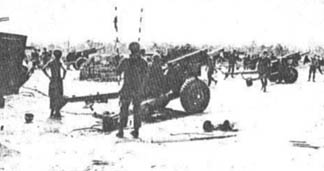 |
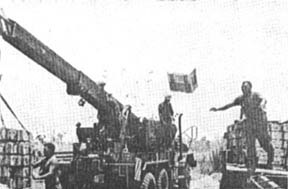 |
PLANE TAKES OFF from the old runway. The
engineers and equipment in the foreground will soon widen and resurface the old runway to
better the landing and taking-off. (PHOTO BY SGT ROGER WELT)
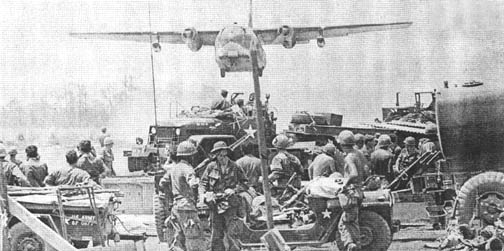
| SWINGING ENGINEER – It tales a lot of muscle to trim down the elephant grass at Thien Ngon. This trooper helps to create Fire Support Base Ord. (PHOTO BY SP4 PETE FREEMAN) | 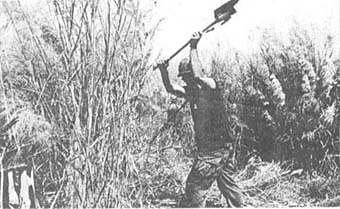 |
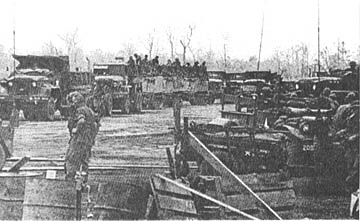 |
TRUCKS AND APCs from the 4th Battalion (Mechanized), 23d Infantry, line up to start the long journey home. (PHOTO BY SGT ROGER WELT) |
Page 6 TROPIC LIGHTNING NEWS May 26, 1969
588th Engr Battalion 'Builds Up' Dau Tieng
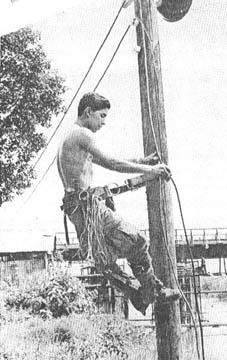 DAU TIENG - Soldiers from Company C of the 588th Engineer Battalion are fast
becoming known as the 'Home Builders' of the Division’s 3d Brigade base camp at Dau
Tieng.
DAU TIENG - Soldiers from Company C of the 588th Engineer Battalion are fast
becoming known as the 'Home Builders' of the Division’s 3d Brigade base camp at Dau
Tieng.
But the dwellings are not always the conventional type and many are not even
for people. The newest residents patronizing the construction boom by C Company are huge
self-propelled 175mm artillery pieces, sleek cobra gunships, tons of fuel and ammunition,
and even several Air Force spotter planes.
"We learned a lesson the hard way when we began constructing homes for
the big artillery here," recalled First Lieutenant James Eagan, from New York City.
"Our first gunpads couldn't take the tremendous shock and vibration stirred by these
monsters, so we had a situation of back to the drawing boards. Now the gunpads we're
building will take anything the artillery can hand out."
With more action in War Zone C, aviation units at Dau Tieng needed more
protected parking slots for an increased number of helicopters. Getting the most from C
Company’s pre-fab yard the engineers built rows upon rows of defensive gunship
revetments.
One of the new revetments paid for itself the first night it was completed. A
new corrugated barrier that housed a Cobra, took the brunt of a 122mm rocket that smashed
in the ground a short distance away. The chopper, unscratched, was flying missions the
next day.
The helicopter re-arm point at Dau Tieng was just a series of steel conex
containers along the refuel lanes before C Company was charged with making a more
permanent home for the deadly rockets and ammunition that stock Tropic Lightning
helicopters.
"The rainy season was coming so we knew we would have to work a little
faster than usual," stated Captain Bernard Stalmann Jr., C company commander.
"I'm really proud of my men, they worked day and night finishing a complete and
sophisticated re-arm point in what must be a record five days," concluded the
Greensburg, Pa. captain who is serving his second tour of duty in Vietnam.
Instead of just building normal protective covering for the Air Force OV-10
aircraft that fly forward air control missions for the 3d Brigade, the engineers also
added a new RPG screen atop the nine foot walls of corrugated steel and dirt that surround
the jet gray Broncos.
Realizing that in Vietnam, a soldier’s home should also be his castle,
the 588th Engineers did not forget the foot soldier. Fifty new bunkers all with RPG
screens, now circle Dau Tieng base camp. Only one section of the base’s perimeter
remains unlit at night. First Lieutenant Eric Shannon, 1st platoon leader from Columbus,
Ohio, and his men are speeding completion of the more than 300 spotter lights that will
soon cover all avenues to the 3d Brigade base.
Last, but certainly not least, every time soldiers drink water at Dau Tieng
they should thank the men of C Company for building the three main water points that
support the 3d Brigade base.
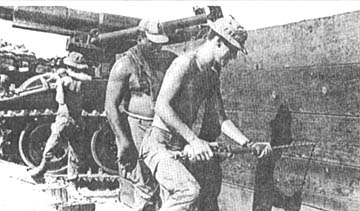 UP AND AWAY -
[Photo, above right] Perched above the Saigon River,
Specialist 4 Thomos Ippolito, a 20-year-old 588th Engineer from Brooklyn, N.Y., installs
some of the 12,000 feet of wire used for the lighting system at the Dau Tieng Bridge.
UP AND AWAY -
[Photo, above right] Perched above the Saigon River,
Specialist 4 Thomos Ippolito, a 20-year-old 588th Engineer from Brooklyn, N.Y., installs
some of the 12,000 feet of wire used for the lighting system at the Dau Tieng Bridge.
DRILL - [Left] Building a home for one of the big guns that support the 3d Brigade, Private First Class Joe Donovan of Southington, Conn., drills as Staff Sergeant Willie Wilson of Petersburg, Va., supervises and Specialist 4 Mike Hays of Susanville, Calif., hammers.
| Story and Photos by SP5 Rick Adams |
Cavalry Slick to Retire
By John T. Agnoletti
CU CHI - Sometime in May, a UH-1D troop-carrying helicopter from Delta Troop,
3d Squadron, 4th Cavalry, will retire from duty. At this time the ‘slick’ will
have logged over 2000 hours in the air over Vietnam since it came here nearly four years
ago.
The helicopter had a variety of missions with Delta Troop. The slick has
flown dust-offs, transported the aerorifle platoon, inserted and extracted Rangers, and
was used constantly as a resupply ship.
In its four years of flying with the Cav, the ship has taken over a hundred
rounds from enemy gunners. In the end, old age claimed what Charlie never could.
Warrant Officer2 Russell Mattison from Mt. Lake, Minn., likes to tell of the
time the ship was involved in an emergency resupply of Charlie Troop of the 3/4 Cav. In
early 1968, C Troop was hit hard by a numerically superior force. The men were almost
completely out of ammunition so D Troop was called to resupply them.
Loaded with ammo, the ship landed on a rice paddy dike in the midst of
crossfire. Enemy fire cracked the tail beam of the ship, but not before the ammo was
unloaded. Shortly thereafter the enemy was repulsed.
The longevity and durability of the ship reflects the dedication of the
slick’s crew chief and the maintenance platoon for their ,job.
The crew chief, Specialist 4 Charles Lowe from San Francisco, Calif.,
performs a daily maintenance cheek on his ship and the maintenance platoon has the
necessary skills for the major repairs.
Page 7 TROPIC LIGHTNING NEWS May 26, 1969
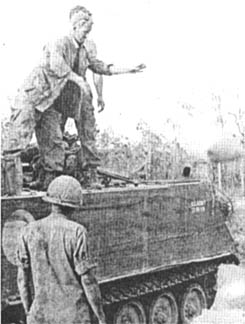 |
RICE
WORK - At right First Lieutenant Richard Nash of
Joy, Ill. examines part of the 49,000 pound rice cache found in the upper
Trapezoid. In the photo at left mechanized infantrymen of the Triple Deuce
off-load a portion of the salvable rice. An estimated NVA battalion will have to
tighten their "collective" belts as a result of this steal.
Photos by |
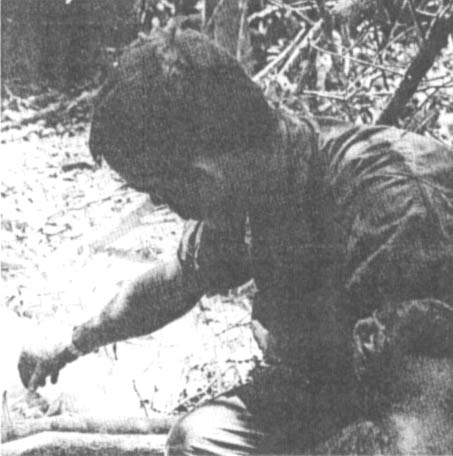 |
3d Brigade Finds Bonanza
(Continued From Page 1)
grenades, 50 AK-47 rounds, 200 .30 caliber rounds and four Chicom hand grenades.
"There were about 250 bunkers and we just couldn't blow all of them.
We'll have to come back later and finish the job," said First Lieutenant Richard Nash
of Joy. Ill., a platoon leader with Alpha Company, 2/22 Infantry. "Some of the
bunkers were so tough we had to use three and four blocks of C-4," he said.
"Those bunkers we ran into were definitely constructed by hard core NVA
elements," said Sergeant Lon Oakley of Dallas, Tex. "You could tell because of
the heavy fortifications. The NVA planned on staying right here, there’s no
doubt," he said.
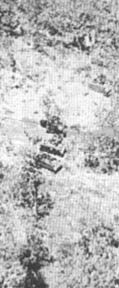 During the fighting, Colonel Louis J. Schelter Jr. of Columbus, Ga., the 3d
Brigade commander, circled the area in his command and control helicopter and evacuated
four wounded Gls, even though the ship was unable to touch down completely because of
treacherous terrain.
During the fighting, Colonel Louis J. Schelter Jr. of Columbus, Ga., the 3d
Brigade commander, circled the area in his command and control helicopter and evacuated
four wounded Gls, even though the ship was unable to touch down completely because of
treacherous terrain.
His pilot, Warrant Officer Gunter Siedler of Torrington, Wyo., said he had
about one foot clearance around his rotor blades when he tried to land in the tangled
bamboo. "I couldn't sit down completely because of numerous bomb craters," he
said.
All indications now are that the enemy has completely withdrawn from the
area, dragging whatever was left of his cache with him. Brigade leaders are keeping their
eyes open, and search operations continue in the Trapezoid.
AERIAL VIEW – Tracks from the 2d Battalion (Mechanized), 22d Infantry, move through an enemy base camp area while Wolfhound infantrymen sweep ahead in the dense undergrowth searching for bunkers housing munitions and food caches. The complex, four miles east of Dau Tieng was the scene of bitter fighting.
|
|
|
EMERGING – [Below] At right First Lieutenant
Richard Nash comes out of an enemy bunker in the upper Trapezoid after his unit, Triple
Deuce’s Alpha Company, with three other companies smashed into the base camp killing
102. |
| PREPARING to blast an enemy bunker, Sergeant Lon Oakley of Dallas cautiously moves into the entrance with two blocks of C-4 explosive. | 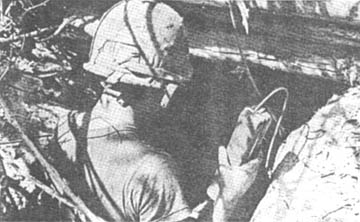 |
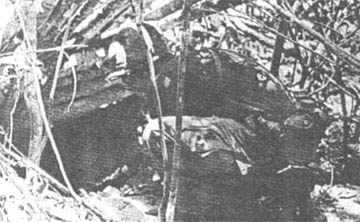 |
PROCEED WITH CAUTION – Sergeant Lon Oakley prepares to check out an enemy bunker. Oakley’s unit, A Company, 2d Battalion (Mechanized), 22d Infantry, was engaged in bitter fighting at the NVA base camp. |
Page 8 TROPIC LIGHTNING NEWS May 26, 1969
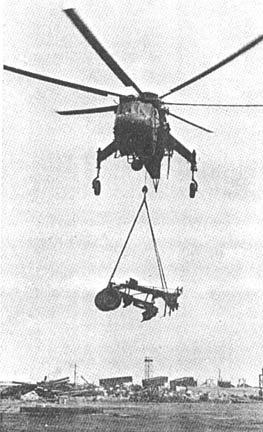 12-Ton Grader Dusted Off
12-Ton Grader Dusted Off
To Nui Ba Den Location
TAY NINH - How do you get a twelve-ton road grader from Tay Ninh base camp to
the top of Nui Ba Den Mountain?
The answer is simple: all you need is five men from the 65th Engineer
Battalion and one powerful flying crane.
A decision was made to do some heavy construction work at the signal site on
Nui Ba Den. To do the job effectively it was necessary to get road working equipment up to
the mountain as soon as possible.
"They gave our engineering battalion the mission to prepare a
Caterpillar 112 Road Grader for a little trip to Nui Ba Den," said Sergeant First
Class Ed Segers of Woodbridge, Va. "We drove it down to the resupply pad at first
light and began the task of dismantling the equipment so it could be airlifted."
"A flying crane is powerful enough to lift equipment weighing twelve
tons, but because of the way the weight is distributed on the 'Big Cat' we had to break it
in half," said Specialist 4 Gary Adams of Petosky, Mich.
After 30 hectic minutes of loosening bolts and turning screws, the breaking
point was reached.
"Put 'er in gear and back up," said Segers, and a few seconds later
control cab and grader blade were in two separate locations.
The timing was perfect. The crane appeared overhead and Specialist 4 Dave
Naftzger of Valley City, Ohio, rushed to get the canvas straps that would join grader and
crane.
"It was a little hard standing on that cab and slipping the strap on
that giant hook, but we did it," said Naftzger.
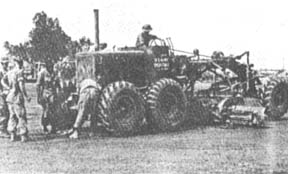 Within 45 minutes, the crane that had lifted the cab to the mountain returned
for the blade section and was headed back to Nui Ba Den. The entire operation was
completed in less than two hours.
Within 45 minutes, the crane that had lifted the cab to the mountain returned
for the blade section and was headed back to Nui Ba Den. The entire operation was
completed in less than two hours.
ON THE WAY - [Above] Five tons of road leveling grader
blade is lifted to the top of Nui Ba Den. (PHOTO BY SGT HERB
BURDETT)
READY - [Right] The big machine a 25,000 pound road
grader is prepared for airlifting to the top of Nui Ba Den. (PHOTO BY SGT HERB
BURDETT)
Hounds Master Ambush
DAU TIENG - From a nearby rubber plantation to the Boi Loi Woods, Charlie
Company, 1st Battalion, 27th Infantry, is teaching another Charlie a lesson in his own
forte - the art of ambush.
During a recent five-day period, the Wolfhound infantrymen successfully
sprang six ambushes, killing 11 enemy soldiers and capturing nine AK-47 rifles. In sweeps
near the ambush sites, they also uncovered two munitions caches.
Captain Lloyd Yoshina, the company commander, credits his unit’s recent
successes to new ideas in ambushing - "stay behind" daylight and night time
ambushes using platoon-size or smaller units.
"We move into an area in force and drop off stay-behind patrols along
strategic routes," commented the Honolulu native. "The rest of the unit moves
away and sets up other ambushes."
In many cases, munitions and foodstuffs are uncovered near ambush sites.
Unsuspecting enemy soldiers returning to their caches lead the Wolfhounds to hideouts.
Conversely, ambushes are always set up when a cache site is uncovered.
Two such caches were uncovered within 150 meters of three successful ambushes
that resulted in six enemy soldiers killed and five weapons captured. The first cache,
found in the bottom of a dry well, contained 113 RPG rounds and 2,500 rounds of AK-47
ammunition. The second was uncovered at a nearby docking site. A bunker was discovered and
the Wolfhounds probed it with bayonets locating a false wall that concealed a tunnel. A
search of the tunnel netted 70,000 rounds of AK-47 ammo and 25 Chicom claymores, as well
as other munitions and supplies.
"Charlie Company is doing a fine job of disrupting the enemy’s
movement," commented Major "Doc" Holliday, battalion operations officer.
"The ambushes keep the enemy constantly on the move with little chance to rest. They
deny him access to his favorite infiltration routes and resupply areas."
Wolfhounds Overrun NVA Base Camp
DAU TIENG - Charlie Company, 1st Battalion, 27th Infantry, after nearly a day
of skirmishing with Viet Cong elements in a thickly wooded area three miles east of Dau
Tieng successfully overran a company-sized enemy base camp, killing eight enemy soldiers
and confiscating two weapons.
The Wolfhound company was engaged in sweep operations in the area when it
received fire from an estimated platoon-sized North Vietnamese Army Force defending the
base camp area.
With the aid of artillery and tactical air strikes the company was able to
penetrate the camps defenses and establish a defensive perimeter.
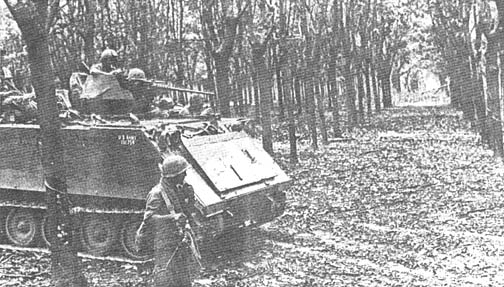 Later, Alpha Company Wolfhounds joined its sister company and, with firepower
from tracks of Alpha Company, 2d Battalion (Mechanized), 22d Infantry, swept into the
area. They found, in addition to the eight enemy bodies, one AK-47 rifle, one RPG-2 rocket
launcher and about one pound of documents.
Later, Alpha Company Wolfhounds joined its sister company and, with firepower
from tracks of Alpha Company, 2d Battalion (Mechanized), 22d Infantry, swept into the
area. They found, in addition to the eight enemy bodies, one AK-47 rifle, one RPG-2 rocket
launcher and about one pound of documents.
The companies also discovered two bunker complexes, one housing a heavily
fortified command bunker.
"We found a large bunker that looked sort of like a dormitory,"
said Major Jerry Holliday of Memphis, Tenn., the Wolfhounds' operations officer. "The
bunker contained several articles of feminine apparel," he said.
EASY DOES IT - A Wolfhound infantryman from
Alpha Company, 1st Battalion, 27th Infantry, moves cautiously ahead of a track from Alpha
Company, 2d Battalion, 22d Infantry, during an operation in a thickly wooded area three
miles east of Dau Tieng. (PHOTO BY SP5 JACK R. ANDERSON)
Thanks to
Ron Leonard, 25th Aviation Bn., locating and mailing this issue,
Kirk Ramsey, 2nd Bn., 14th Inf. for creating this page.
This page last modified 8-12-2004
©2004 25th Infantry Division Association. All rights reserved.